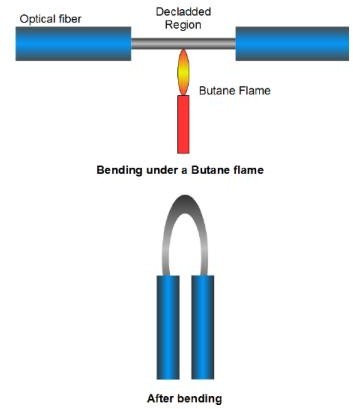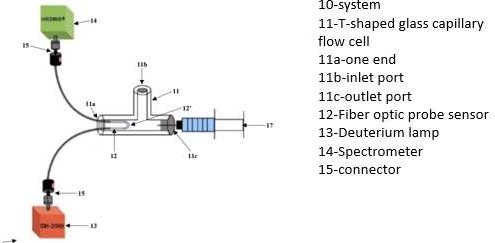The present invention provides a method for label free detection of analytes in a sample, wherein the analytes may be selected from the group of micro-organisms, macromolecules, and small molecules. The present invention also provides a system for label free detection of analytes in a sample comprising a flow cell which houses fiber optic probe sensor immobilized with plurality of receptors for detection of said analytes and wherein the detection is based on the measurement of optical property of the said analyte.
The detection of pathogens, small molecules, and macromolecules in various samples typically requires labeling techniques, which can be time-consuming, costly, and lead to the alteration of the analytes. Current diagnostic techniques, like culturing or using labeled biosensors, have limitations in terms of sensitivity, speed, and complexity. Additionally, many existing methods are expensive and involve complex fabrication processes.
- Label-Free Detection: The technology does not require any additional labels or tags (fluorescent, radioactive, or other modifications) to detect analytes, reducing costs, preparation time, and potential interference from labeling agents.
- Enhanced Sensitivity: The use of a fiber optic probe sensor with receptors immobilized on a U-shaped optical fiber allows for high sensitivity by measuring optical absorbance changes at 280 nm (UV range), which provides precise detection even at very low concentrations of analytes (as low as 1 cfu/ml for bacteria).
- Flexible Detection: The system can detect microorganisms, macromolecules, and small molecules with rapid response times. It works with both fixed volumes and continuous flow setups, making it adaptable for various types of samples.
- Cost-Effective: Compared to other optical sensing technologies (e.g., Surface Plasmon Resonance), the system reduces both cost and complexity in terms of instrumentation and sensor fabrication.
- Improved Performance: By using evanescent wave-based sensing through optical fibers, the detection does not scale with sample volume, allowing for detection with low sample volumes and higher accuracy.
The prototype consists of a U-shaped fiber optic probe made from high OH silica core fibers, housing immobilized receptors (e.g., monoclonal antibodies) specific to target analytes like E. coli. The flow cell, made from glass, can be designed in various shapes such as T-shaped, straight, L-shaped, or Y-shaped, with sample inlet and outlet ports to accommodate both continuous or fixed-volume flow. The optical setup includes a UV light source, like a Deuterium lamp, and a UV-visible spectrometer or photodiode to measure absorbance changes at 280 nm as analytes interact with the receptors on the fiber probe. The fabrication process involves bending the fiber using a butane flame, cleaning, silanizing, cross-linking, and then treating the probe with antibodies specific to the target analyte.
The technology is at hypothesis testing; demonstration in lab/animal model stage.
4
The technology has significant societal impact across multiple sectors. In public health, it can improve diagnostics for waterborne pathogens, providing rapid detection of harmful microorganisms like E. coli and Salmonella, helping prevent disease spread, especially in resource-limited regions. It also enhances water quality monitoring by offering quick, cost-effective detection of pollution. In healthcare, it enables faster, non-invasive testing for infections or biomarkers, benefiting point-of-care applications in areas with limited resources.
- Medical Diagnostics: Point-of-care diagnostics for rapid bacterial or viral pathogen detection; detection of proteins, nucleic acids, and other biomarkers in clinical settings.
- Water Quality Monitoring: Detection of pathogens in water sources for public health and environmental monitoring
- Food Safety: Detection of foodborne pathogens in the food industry for ensuring safety and compliance with health regulations
- Pharmaceutical Industry: Drug discovery and development by monitoring interactions of molecules or drugs with receptors
- Biotechnology: Utilized in various biotech research applications, including biosensing, biosafety, and bioremediation studies
- Environmental Science: Used for environmental health surveillance, particularly in detecting microbial contamination in water, soil, and air
Geography of IP
Type of IP
3840/MUM/2014
422412


